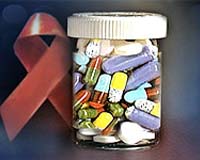In a Bangkok go-go bar, a prostitute in a transparent miniskirt who goes by the name “Joy” said she’s ready to benefit from one of the biggest scientific breakthroughs in the 30-year fight against AIDS.
The 23-year-old sex worker says she’d like the chance to use Gilead Sciences Inc. (GILD)’s pill Truvada to help protect her from becoming one of the 530,000 people in Thailand with HIV.
“I am scared,” she said, during a break at the bar. “I want to find a husband. If it works, I’ll take it.”
Truvada, a staple of treatment for patients with HIV, was approved today in the U.S. to lessen the risk of infection in healthy people by as much as 94 percent when taken regularly. As researchers struggle to develop an AIDS vaccine, having a daily pill to block the virus could be a crucial interim step to rein in the disease. Yet rather than celebrating Truvada’s effectiveness, global health planners are now facing a difficult moment of soul searching over how to allocate limited resources.
“On the surface it’s something amazing, you can prevent HIV with a pill,” said Kevin Robert Frost, chief executive officer of amfAR, The Foundation for AIDS Research. “But then you start to dig deeper and it gets really complicated. When I get to the question of who pays for this I am completely dumbfounded. In developing countries, most of them can’t afford to give pills to those who are HIV positive.”
Treatment Cost
The human immunodeficiency virus, which can cripple the body’s immune system if left untreated, killed 1.8 million people in 2010. Of the estimated 15 million who needed treatment, just 6.6 million in low- and middle-income countries received the cocktail of drugs that can prolong lives and lower the virus to undetectable levels, according to UNAIDS, the UN’s program on HIV/AIDS. To get the drugs to those already infected would cost $6 billion on top of the $16 billion spent fighting the virus last year, UNAIDS said.
This weekend, more than 20,000 activists and researchers will gather in Washington for the first International AIDS Conference to be held in the U.S. in 22 years. Much of the focus of the weeklong conference will be on preventing the more than 7,000 HIV infections a day worldwide, and discussion will center on how to put the latest breakthroughs, including Truvada, into action in the regions where they are most needed.
Francois Venter, deputy executive director at the Wits Reproductive Health and HIV Institute in Johannesburg, said he was “blown away” when researchers reported in 2010 that Truvada cut the risk of healthy people contracting the virus. Since then, though, he said he has been able to prescribe it as a preventative to only a few patients who can afford the $480-a- year cost. In South Africa, where almost 1 in 3 people live on less than $2 a day, the drug is out of reach for most, he said.
“In a general epidemic like ours, we need interventions that can be used by the general population,” said Venter, who works in South Africa where 5.6 million people are infected. “I don’t know how you practically could do that.”
In the U.S., where the median household income is more than $51,000 a year and the majority of people have health insurance, the U.S Food and Drug Administration cleared marketing of the drug for prevention as well as treatment. The FDA said Truvada should be used along with other safe sex practices, like condoms and counseling, and only in people confirmed to be HIV negative who are at high risk of getting the virus.
